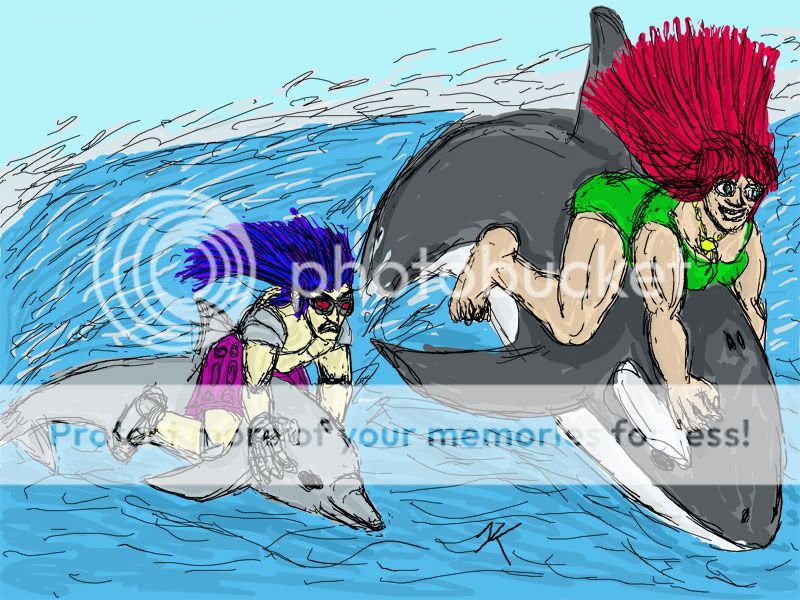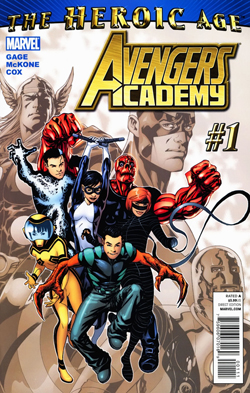 For the pages in question, go here
For the pages in question, go hereNemesis, the new creator-owned series by Mark Millar and Steve McNiven, is about a Batman-type vigilante who uses his unequaled skills and resources to cause crimes, rather than fight them. In the second issue, we find out the origin of Nemesis; when young Matthew Anderson's parents were arrested for hunting transients as sport, he trained himself to be the greatest criminal ever. And I quote...
" Bored shitless with his [Matt's uncle and legal guardian] endless choir practice and impeccable manners, I ran away and travelled the world, learning at the feet of its magnificent bastards. By twelve I was a gang lord. At fifteen I was Asia's largest drugs exporter. At twenty-three I headed a Zoroastrian death-cult and was finally ready to honor my mother's dying wish. "Note how all of this is caption narration over a panel where we see a young man in a hooded sweater in a dark alley. Obviously, this is a take-off on how Bruce Wayne travelled the world to learn the ninja skills he would use as Batman. However, there are some questions raised by this, such as
1.) Why would all these " magnificent bastards " train Matt in their criminal trades? Do they take time off of stealing and murdering to mentor at-risk youth in super-villainy?
2.) How did a teenaged boy, even a precociously evil one, run a criminal empire successfully without ever getting caught?
3.) Why would he run a death cult with its name attached to an ancient religion practiced today only by hundreds of thousands ( most of whom, I'll wager, are NOT mass-murderers ).
4.) Are we going to see any of this on panel?
The answers are; not explained, not explained, not explained, and probably not. Many stories have been done about Bruce Wayne's pre-Batman life and his training in martial arts; they devoted a whole movie to it ( Batman Begins ), and it was a very good movie. Millar's logic seems to be that because we get the joke that Nemesis is Batman with the serial numbers filed off and his morals ( and color scheme ) flipped 180 degrees, we can get the joke that Nemesis would just have the same background, except trained by the wicked instead of the virtuous.
See, 70 years of Batman writers already did all the work, so Millar can just piggyback on our familiarity with Batman!
Of course, that's the way the entirety of Nemesis works. It is a story that relies on better stories to do its heavy lifting. We know that Officer Blake Morrow is supposed to be Comissioner Gordon, so we don't need to hear too much about who he is as a character, what makes him tick, how he gets along with his family ( a brief comment to his partner about Morrow's arguments with his wife is dropped in a mechanical fashion ). We know that Batman has a bunch of wonderful toys, so we don't need to see what makes Nemesis' tech any more special. We know that the Joker is the homicidal artist that Nemesis is aping, so we don't need to see any particularly unique crimes. After all, the late Heath Ledger's epic performance set the groundwork for the entire media-friendly world appreciating the Joker, so all that Nemesis needs is for us to " hear " Ledger's voice when we read the guy's word balloons!
The truth is, all I can hear from Nemesis is Christian Bale's Batman voice, trying for intimidating and ending up with ridiculous growling.
The galling part is that this comic is under Marvel's creator-owned Icon imprint, but there's very little actually CREATED here*. This is a lame joke about an iconic superhero character, stretched out in an attempt at a story. It's not entertainingly over-the-top, because it sticks so close to the source material. It's not deep, because it doesn't expand far beyond what we already know about the characters and tropes. And while there's a plot that will be going on for two more issues, thus far all we've seen is the most rudimentary duel of wits we can imagine; " I planned for you to fail like that! " " No, I planned YOU to fail like that! ". There aren't characters, there aren't conflicting ideologies, and there are barely thrills.
If you want a great story about a superhero gone bad, read Mark Waid and Peter Kruse's Irredeemable-- it's a Superman gone bad and not a Batman, but it's got much more depth and suspense. If you want a great story about a Batman analogue raised towards evil, read the Prometheus story in Grant Morrison's second JLA Deluxe hardcover. I suppose if you want a story that's an exact replica of " What if Batman was bad ", without ties to any character outside the Batman mythos, Nemesis is your book. But you should probably wait for the inevitable movie made from Millar's Nemesis script, because the cast and crew there are much less likely to phone it in.
* At least not by Millar; Dave McCaig offers excellent colors, and Steve McNiven draws in a rougher style that looks much more appealing than his hyper-rendered work on previous Millar titles. It's a shame that Millar has kept us from seeing McNiven's artwork on a decent story on three consecutive occasions.







